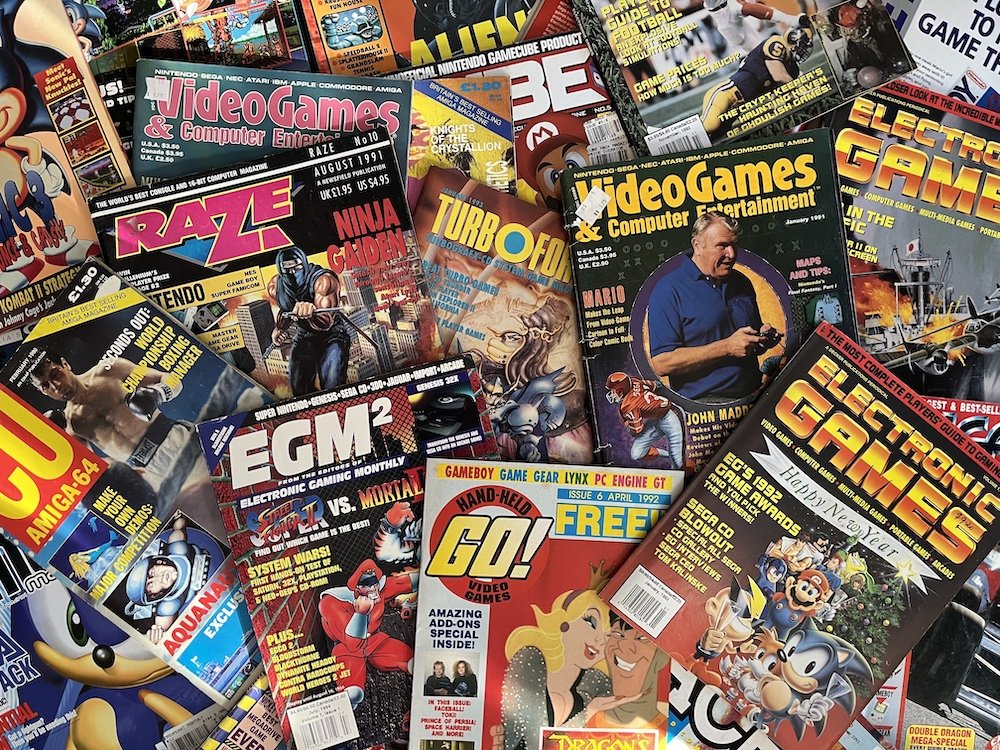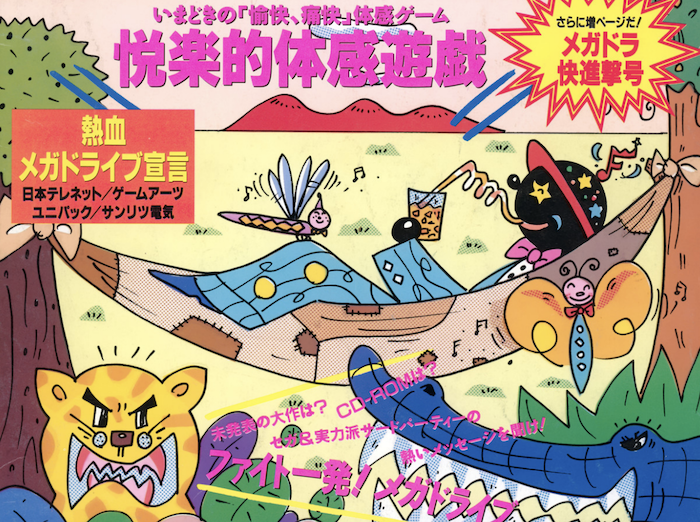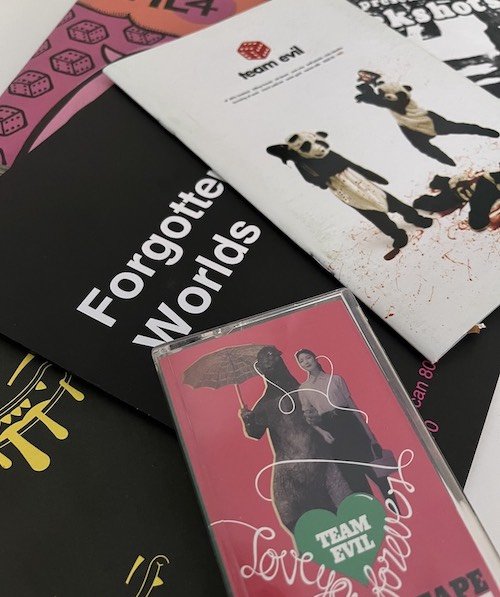A celebration of classic video game magazines
Latest articles
Sega Blue Skies
All you really need to know is that the final version of the magazine comes with a series of Sega Blue Skies inspired postcards, which you can use to create your own front cover.
Video Game print ads
“That's something that's never brought up in discussions about old video-game magazines. Having a good ad salesperson directly impacted the appeal of your magazine at the newsstand.”
Chris Brieniek from VG&CE talks 90s magazine publishing.
Sega Visions magazine
“Sega Visions was important in the early days of the Genesis. We had a big mailing list that we got from Tonka who had distributed the Master System. We used it to help get Master System owners to switch to Genesis.”
I spoke to the man who launched Sega Visions magazine.
Latest blogs
Beep! Mega Drive magazine
For a brief period in the early 90s, Beep! Mega Drive was home to some of the best magazine cover art you’re likely to come across.
Blue slimes and zines. On media and publishing
I think of social media, content and publishing in JRPG terms. Each activity has an associated number of experience points attributed to it.
The Al Nilsen interview
Al Nilsen joined Sega of America in 1989 and was responsible for some of the 16bit era's most memorable campaigns including Sonic 2sday and Genesis does…
Highlights
Super Play magazine
“Suddenly, I was pretending to be an anime-style illustrator.”
I spoke to Wil Overton, the man responsible for those iconic Super Play covers, about the magazine’s legacy, and why it’s so fondly remembered.
Video game fanzine history
If old gaming magazines provide a glimpse into a world that no longer exists, fanzines add context and help colour in the details…
A look back at video game fandom before the internet.
Computer and video games
Computer and Video Games magazine (CVG) ran for four decades. Originally launched in 1981, it would appear on newsstands until 2004. The online edition carried on until 2014. But I don’t care about any of that…
Retrospectives
From EGM to 1up.com
Magazines change over time. New editors, new creative direction, different console generations.
So the Electronic Gaming Monthly (EGM) I grew up reading in the early 90s is very different to the EGM that was on-sale at the turn of the millennium.
I reached out to Greg Sewart - who was at the publication from 2000 to 2003 - to talk about those differences, the evolution of the magazine, and how the launch of its online portal (1up.com) ultimately doomed the print edition.
Sega Visions magazine
Retro gaming, history, and search in the age of (Ai)
“Sega Visions was important in the early days of the Genesis. We had a big mailing list that we got from Tonka who had distributed the Master System. We used it to help get Master System owners to switch to Genesis.”
I spoke to the legendary Al Nilsen about Sega Visions magazine… And how (Ai) is impacting retro gaming history and online search.
Video Games & Computer Entertainment magazine
From VG&CE to Video Games: The Ultimate Gaming magzine
“The 90s was a period of rapid technological acceleration. It was also a time of massive cultural shifts.
Video Games and Computer Entertainment (VG&CE) magazine is a physical manifestation of that chaos. For better or worse, its shifting fortunes and editorial tone reflect the decade’s evolution.”
Video Game magazine history
An abridged history of video game magazines: 1981-1996.
“The history of video game magazines is also the history of the late 20th century and the global convergence of media and technology.”
A closer look at how UK and US video game magazines developed in parallel throughout the 80s and 90s.
Mega Drive box art
…the art and commerce of selling video games.
While both the US and Japan have a rich history of graphic design, the US video game market largely failed to tap into that history or skill set. Because as far as the market was concerned video games were for kids. And 12 year olds aren’t known for their discerning eye for graphic design.
Lost in Cult
From [lock-on] magazine to a Handheld History
“I sold so many of my things, put everything I had creatively and emotionally into the project. It was a massive risk.”
I spoke to the CEO and Creative Director of Lost in Cult, Jon Doyle, about his journey from Kickstarter campaign to a booming publishing empire comprising [lock-on] magazine, bespoke projects, and the newly launched Handheld History book with HarperCollins.
NGamer maagzine
Social before social media
“By and large, the internet felt like a huge beast of a competitor, beating us to news, previews and reviews of just about everything.”
Former NGamer editor Mark Green talks Nintendo fandom, cover-mounted DVDs, and how the arrival of smart phones and social media changed everything.
Sega Pro
The magazine that launched a publishing empire.
Richard Monteiro made his name as a staff-writer for various 8bit magazines before launching his own publishing company.
Sega Pro was the first magazine he released and the start of the Paragon Publishing empire. A decade later he would cash out for cool £16 million pounds. This is that story. Abridged…
How the internet killed video game magazines
“When I first started in games magazines, the internet was a kind of goofy thing and advertisers were reluctant to pump dollars into it. As soon as the internet gained any momentum in gaming circles, you could watch circulation and advertising revenue falling in real time.”
I spoke to the writers and editors who were there between 1995 and 2005 to find out what happened to your favourite video game magazines.
Megazone
The murky history of Sega OziSoft and its unofficial magazine
Megazone’s influence on Australian gaming can’t be underestimated. It made Sega a household name, sold a generation of kids on the Master System, and took the Mega Drive to even greater heights.
But behind the scenes the line between editorial and marketing was precariously thin.
UK:Resistance
The Gary Cutlack interview
“I spent the best part of three months doing nothing but previews and reviews of Radiant Silvergun,” is how Gary Cutlack describes his time at the ill-fated Sega Saturn magazine.
Which sounds like fun. But we’re here to discuss his legendary website - UK: Resistance. Founded in 1996, it blazed a HTML trail through the internet, was sold to venture capital, and had a ‘tone-of-voice’ that would probably get you arrested in this day and age.
GamePro magazine
Welcome to the 90s
Launched in 1989 to cover the rapidly growing U.S. home console market, GamePro would become one of the leading video game publications of the era, eventually branching out into TV, trade shows, and this wild new thing called ‘the Internet’
Michael Meyers was there from the start. A senior editor at the magazine, this is his take on an industry in transition, and the rivalries that played out behind the scene.
Electronic Gaming Monthly (EGM)
The untold history
EGM didn’t just shake up the U.S. publishing landscape, it provided an alternative to the U.K. gaming media we knew in PAL territories. Its reference points, attitude, design and console coverage was a complete break from what CVG and Mean Machines readers knew.
So when import copies of EGM first began to appear in PAL markets in the early 90s it was like a glimpse into an alternative reality.
Sega Power
Documenting Sega’s rise and fall in the 90s
If you were a Sega fan in the early 90s you had dozens of magazines to choose from. But what happens when a console starts to lose momentum, and you’re left with 100 pages of content to fill every month? How do you get excited about the 32X or the Mega CD when you’re privy to the grim sales forecasts?
Former Sega Power editor Dean Mortlock takes us behind the scenes.
The MegaTech story
As told by Paul Glancey
If you’ve ever wondered about the evolution of CVG magazine, the state of the Mean Machines office, and how all that eventually led to MegaTech you’re in the right place.
Here’s several years worth of publishing industry anecdotes, drama, and gossip in fast-forward.
How CVG magazine changed the industry
Computer and Video Games magazine (CVG) ran for four decades. Originally launched in 1981, it would appear on newsstands until 2004. The online edition carried on until 2014. That makes it the longest running video game magazine in history.
But I don’t care about any of that.
I’m interested in the magazine’s early 90s heyday.
What happened to Hyper magazine?
Part 1.
“When I first started in games magazines, the Internet was a kind of goofy thing and advertisers were reluctant to pump dollars into it. Each issue was raking in $50,000 - $60,000 in advertising and selling tens of thousand of copies.”
“As soon as the Internet gained any momentum in gaming circles, you could watch circulation and advertising revenue falling in real time,” former editor Daniel Wilks talks us through the final days of Hyper magazine.
What happened to Hyper magazine?
Part 2.
Hyper magazine was well and truly dead by 2018. It just didn’t know it…
While its quarterly specials still haunted newsagents, the low circulation numbers, dwindling advertising, and a barely there web presence told the real story.
So when it was announced that long serving editor Daniel Wilks was leaving those of us still paying attention assumed it was all over.
But there was still one final chapter…
How Mean Machines wrote the blueprint for games media
While other publications played it safe, Mean Machines filled its pages with in-jokes and irreverent humour, gleefully slagged off terrible games, insulted its readers and, most importantly, put its staff front and centre.
In other words, it was years ahead of the curve, and laid the groundwork for what games journalism would become in the 90s.
Videogames & Computer Entertainment (VG&CE).
A quick look at the press shots of US game magazine editors back in the day reveals heavy ‘dad vibes’. Moustaches, receding hairlines and glasses were all par for the course.
Basically, they all looked like middle-age data analysts. Which is maybe where Jason Schreier got his whole vibe from. But that’s another article…
In the meantime, let’s talk about VG&CE and its campaign against a pill popping Dr. Mario.
Compute! Part 1.
Compute! captures a moment in time. That hazy late 80s period before Nintendo revived the videogame industry, and the home computer market was shifting towards a more homogenised, production line approach.
But Compute! magazine was already a relic by the time I first came across those issues from the local library in 1989. It just didn’t know it.
Compute! Part 2.
“My biggest regret was that we just didn’t have all we needed to become a lifestyle technology magazine like Wired. “
“There was room for another magazine in that space and I wished we’d had what it took to be that magazine.”
Former Editor Peter Cosco looks back at the early 90s tech explosion. And how Compute! missed the boat.
Snapshots
How to create a zine in 2023
The Forgotten World’s zine is available to purchase… here’s the awful truth
“If I sell every single copy I’ll just about break even… which is a terrible business model, but here we are.”
Ever wanted to create a zine? Here’s a deep dive into the process, costs and issues encountered while creating Forgotten World’s issue #0.
Out of Print Archive
Preserving your childhood one magazine at a time.
It takes Out of Print Archive approximately 40-50 hours to scan and preserve each magazine. That sounds insane. But as the man behind it explains,
“These magazines are such great time capsules. They’re an anchor to times that would otherwise be forgotten completely. I just want to see these great magazines preserved in a way that would make the original creators proud.”
The rise and fall of Mega Drive shmups
Via reviews in CVG & Mean Machines.
The first generation of Mega Drive games was defined by small Japanese developers who could bang out a shmup on a tight budget with a small team. Sega needed third party titles for its new 16-bit consoles and happily published these games to help bolster the Mega Drive’s library.
But as Sega’s fortunes changed, and Sonic took the Mega Drive mainstream, the system’s library began to change.
Diehard GameFan had drama
(DieHard) GameFan magazine began life as a mail order catalogue. You’d find their ads in the back of EGM; it was all hastily cropped manga images, import titles from Japan, and hyperactive use of exclamation marks!
Eventually they ‘pivoted’ to publishing a full blown magazine, which was known for three things;
Ridiculously hyperbolic praise of obscure titles
Eye bleed layouts that made it hard to read the text
Poor grammar and typos
The PlayStation effect
How Sony and club culture forever changed video game magazines
Video game magazines at the start of the 90s were scrappy, juvenile, and filled with animal mascots bouncing through colourful 2D levels.
That would all change in a few short years. The arrival of Sony, and their efforts to hitch PlayStation to the emerging UK club scene would forever change gaming and its associated media.
A history of video game magazines.
The first computer and videogame magazines started appearing on newsstands in the early ’80s.
One of the most successful, and longest running, was the UK’s C&VG (Computer & Video Games).
40 years later printed magazines are still here, albeit, they’ve become a more bespoke, specialist medium.
So what happened during the intervening years?
Videogame fanzines. Part 1.
While mainstream magazines (and websites) focus on a news, previews and reviews format, the indies are free to write about whatever takes their fancy.
As videogames have become more complex, lifelike and morally ambiguous over the years, that’s given writers plenty of material to work with.










































